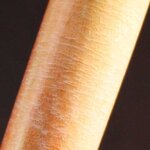Your problem is most likely one of moisture content and growing wood. I agree with those who said that the wood was too dry, and that it expanded after it was finished and allowed to sit at room temperature for several months. The solution is to wait a couple days to give the moving wood a chance to settle down before applying a brittle finish like CA glue. If you can't wait, the simple solution is to use a more flexible finish than CA glue.
The problem can be as simple as the changing humidity in the air over the course of the several months. The difference between the pens being turned and finished in a heated room with a lower humidity and now you are looking at it the middle of the summer when the humidity is higher.
There are several reasons for your problem with growing wood. One is that wood storage can be a lower moisture than room air. Several months in a pile of dry wood can make it a lot dryer than it would have been it it were sitting out in room air. The other problem is that the heat from turning and sanding lowered the moisture content of the wood causing it to shrink more than it expanded from the heat. When finished while it was still warm and dry wood can crack a brittle finish like CA glue as it expands from cooling and absorbing moisture from the air.
Like all other finishes, CA glue will allow moisture to enter and leave the wood; the only difference is that it is slower than other finishes. Most other finishes are also softer and can take a bit of stretching as the wood moves. Only an acrylic plastic will not allow moisture to pass through it, and that can cause other problems.
A CA finish is very brittle and it can take some of the compression as the wood shrinks as it loses moisture, but cannot at all be stretched as the wood expands. Shrinking wood is more likely to show cloudy spots because the wood shrinking under the CA finish can break loose from the finish. Any expansion or movement as the wood returns expands as it returns to equilibrium with the atmosphere will make the brittle CA finish crack.

